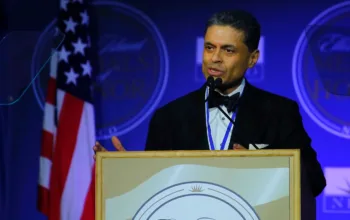Gen Z is channeling climate anxiety and anger into music.
All summer, 24-year-old Augusta Senenssie had Billie Eilish’s song “Overheated” stuck in her head. In June 2022, Eilish hosted a series of climate talks in London by the same name, alongside her UK tour dates. In July and August, the UK faced a series of heat waves, breaking records for the hottest temperatures ever recorded in the country. Senenssie walked around her sweltering London neighborhood with searing music in her ears. Another of her favorites, “Fire on the Mountain” by Asa, portends doom with lyrics like “One day, the river will overflow / And there’ll be nowhere for us to go /And we will run, run / Wishing we had put out the fire, oh.”
As a youth council member of the climate action organization Earth Uprising, Senenssie is closer to the levers of climate power than most of her peers. Her activism has brought her to United Nations conferences on climate change and youth. But that doesn’t necessarily make her more optimistic. “You have people say loads of congratulatory things, and have you go and speak at all of these important summits, but your work has no binding impact on what’s being decided at the high levels that affects everyone,” she said.
Senenssie is not alone in her anger. That doomer tone you’re sensing in the internet ether — where young people are posting memes about this was not only the hottest summer of our lives but also the coldest summer of the rest of our lives — follows a shift in Gen Z’s perception of a climate-changed future. This sentiment slips into the memes they make, the way they relate to their peers and families, and even the music they listen to. TikToks set to Pinegrove’s “Orange,” a song about California’s devastating 2020 wildfire summer, show young fans crying on camera above comments like “doomed species in its death throes” and “I’m giving up.” Like listening to devastating breakup songs after you’ve been dumped, young people are bingeing music about the end of the world to wallow in their climate despair.
To Gen Z, the future doesn’t look bright, but it does look hot
The first Gen Zers came of age alongside the 2018 Intergovernmental Panel on Climate Change (IPCC) special report that detailed the disastrous impacts of a projected 1.5°C global temperature rise. That summer was filled with headlines about humanity having only 12 years left before certain catastrophe, and Gen Z became convinced that their futures were over before they even started.
“This generation feels like they’re facing an unprecedented threat … like, we’re not gonna get through this. This is forever,” said environmental studies professor Sarah Jaquette Ray. In her book A Field Guide to Climate Anxiety, Ray describes asking her class to visualize a positive future where climate change had been successfully mitigated. She found that these students were unable to envision a future of any kind — their anxiety cut off their ability to see themselves living into adulthood.
“I used to listen to a lot of pop-punk music that was all about how it might get better when you grow up. Now it’s like I’m older, and it’s absolutely terrifying and I’m not having a great time,” says Kelsie Herzog, a 25-year-old TikTok creator who makes playlists and gives music recommendations to her 130,000 followers. Her tastes have changed to favor music that captures her anger and fear. One song she has on heavy rotation is “Colony Collapse” by Snag, with lyrics like “The more that I learn, the more I believe the earth is a corpse laid at our feet.”
A 2021 survey in The Lancet showed that 56 percent of people ages 16 to 25 believe “humanity is doomed,” and 75 percent describe the future as “frightening,” highlighting a generational divide in outlook on climate change. Senenssie describes a “patriarchal arrogance” that she encounters as being the fuel to her climate grief. She feels like adults whose daily lives aren’t yet affected by climate change are quick to minimize her fears.
Older generations tend to compare climate change to other threats like economic recessions and wars, Ray confirms. “There’s that kind of battle over whose existential threats were worse.” Older generations who have overcome their own challenges believe Gen Z’s anxieties will be healed with time. But seeing no evidence that an end to climate change is in sight, young people feel dismissed, and seek validation for their fears elsewhere.
Listening to music feels like being heard
That’s why, post-IPCC special report, releases that describe the world ending in floods, droughts, and fires, like Hozier’s Wasteland, Baby!, Childish Gambino’s “Feels Like Summer,” and Soccer Mommy’s “newdemo” are making such an impact with the under-25 set — these millennial songwriters can relate to their generational frustrations and fears.
Tamara Lindeman, 37, of the folk band the Weather Station, describes her lyrics as an attempt to process her own emotions around climate change. “There’s this term ‘soft denial.’ You know, but you act like you don’t know. I was in that place for a few years, just avoiding the topic in my mind, avoiding the topic in the news, and then it just hit me all over again,” Lindeman said. She went on to write lyrics like “I’m pretty tired of this bait-and-switch / I don’t wanna have to smile when I open my gift, and there’s nothing inside it,” which speak to Gen Z’s frustration with older generations who minimize their concerns about the future.
“With other things that you might be afraid of, you might be able to do research and you might be able to lessen your fear.” she said. “With climate, when you do research it, it expands [your fear]. I think what’s important about this issue is fear and grief is an appropriate and accurate response.” Her music reflects that climate anxiety isn’t an emotion to solve or get over. Like her fans, Lindeman experiences it thrumming in the background of her everyday life.
But apocalypse music isn’t some cesspool of anguish from which listeners can never escape. Once fans find validation for their feelings, they look around and find a bunch of other people feeling the same way. “I have this huge community of people that like the same music as me. We can all relate to the lyrics, be sad and angsty and all that stuff. Weird as it sounds, it feels kind of comforting,” says Herzog. Think about the role that music fandom plays in identity formation and community-building in adolescence — the people who listen to your favorite band are the only ones who really get you. Then imagine that, unlike your parents or classmates, the person next to you at the concert takes your deepest fears seriously.
“Say somebody was experiencing anxiety, got involved in the community, found their people, and then got involved in some climate actions,” said Ray. “It wasn’t the actions that they did that alleviated the anxiety. … The antidote to our feelings is the same antidote to the climate crisis, which is community.” The oft-memed idea that individual actions don’t matter in the face of corporate inaction can leave young people feeling powerless, no matter how many car rides or fast-fashion hauls they forgo. But building the kinds of relationships they’ll need for climate resiliency seems much more within reach.
Once young people have an outlet for their grief, it can start to transform. Bartees Strange funneled his own anxiety into his work at a climate advocacy nonprofit for more than five years. Then, disillusioned and burned out, the 33-year-old songwriter quit his job in 2020 to release his debut album Live Forever. He described his frustration with white colleagues for whom climate change was their first personal experience of injustice. “My life has always been impacted by a third party since forever, so I’m watching people in the climate movement go through emotions that I went through as an 8-year-old,” he said. “But when you live through it and you’re able to celebrate, and you process it in a way where you can uplift other people, then grief can become fuel for beautiful things.”
Strange’s music, like Lindeman’s, starts with grief, but songs like “Mulholland Drive” take listeners on a cycle of death and rebirth with lyrics like “I don’t believe in the bullshit of wondering when we die / I’ve seen the ending, it’s all in your face and your eyes / I’ve seen how we die, I know how to lose.”
For young fans feeling like they’re watching the end of the world, Strange offers up the possibility that letting go of one idea of the future makes room for a new one to begin. He hints at what Ray calls the “radical imagination” needed to see a future that lies just beyond certain doom. That imagination is crucial for finding climate solutions, but the trick is that it can’t be accessed by trying to bypass climate emotions with dismissal or detachment.
For Senenssie, that future looks like resisting the pull to pessimism that only wealthy countries can afford. While those least responsible for the climate crisis are already feeling its worst effects, she reminds me, young people in the Global South do not have the luxury of giving in. And listening to music from artists around the world is one way of maintaining her connection to the global climate movement. “The emotions can be sort of overwhelming,” says Senenssie. “But I think of the beauty of the fact that in this movement and in this space together, we feel so deeply, and we’re so interconnected.”
Author: Taylor Behnke
Read More



